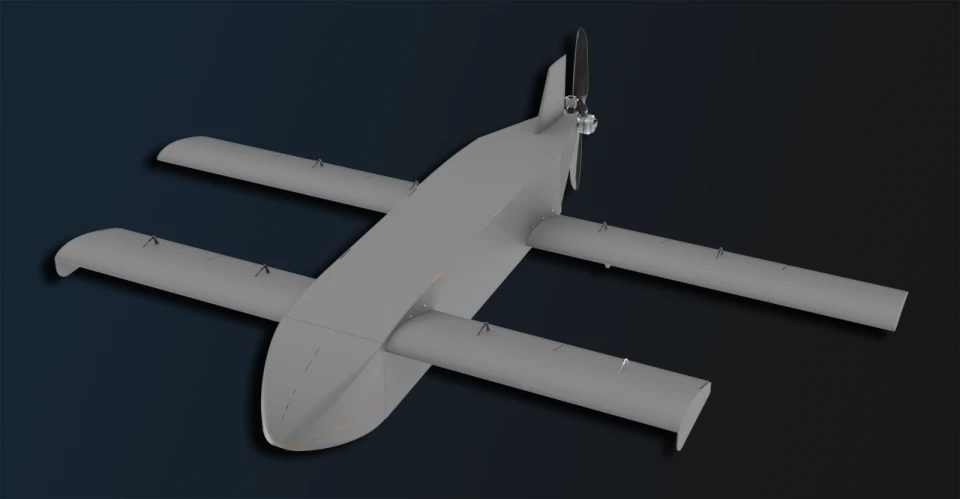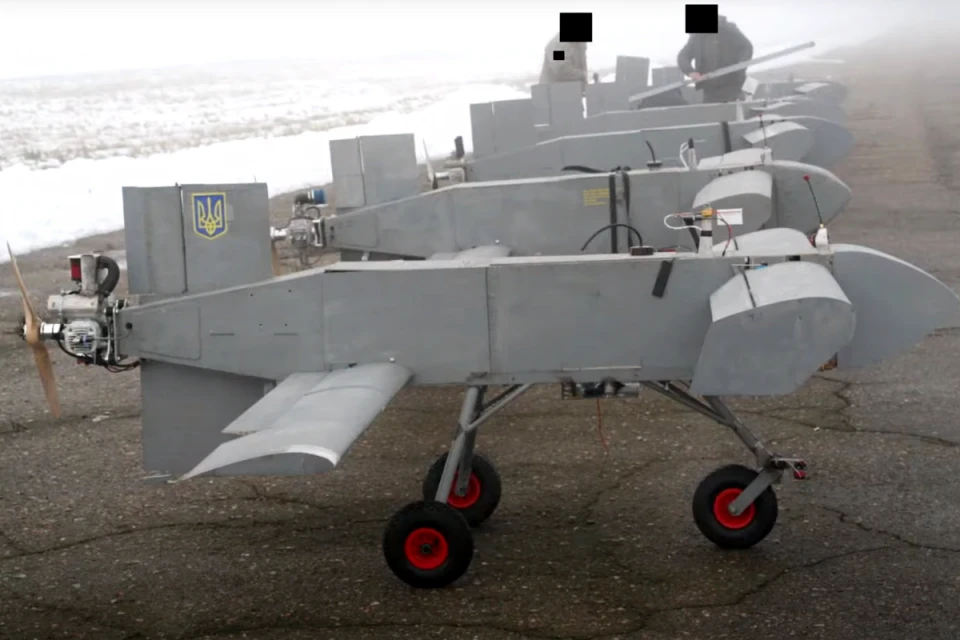
AQ 400 Scythe: New Ukrainian drones, counter to Shahed
The Ukrainian Armed Forces have recently received a shipment of the AQ 400 Scythe kamikaze drones, a domestic production in Ukraine. These drones, closely resembling the Shahed in various aspects, boast the capability to reach Moscow. Experts highlight the remarkably low cost of delivering 1 kg of explosives over a distance of 1 km
Espreso delves into the details of these "Ukrainian Shaheds," covering their technical specifications, distinctive features, and advantages.
Key points covered in the text include:
- What the AQ 400 Scythe is and its composition.
- Tactical and technical characteristics of the AQ 400 Scythe.
- The operational mechanism and cost of the AQ 400 Scythe.
- Insights into drones operating in coordinated "swarms."
What is the AQ-400 Scythe drone, and what materials compose it?
The AQ-400 Scythe kamikaze drone project was introduced in the spring of 2023. On December 13, 2023, Terminal Autonomy, formerly One Way Aerospace, announced on its LinkedIn account the delivery of these drones to Ukrainian defenders. The company currently produces 100 UAVs per month, with plans to expand production fivefold, aiming to "broaden the scope of strategic warfare." Francisco Serra-Martins, co-founder of Terminal Autonomy, told Forbes that the company anticipates manufacturing 500 drones monthly by the 2nd quarter of 2024, with the ultimate goal of reaching a thousand drones each month.
According to Defense Express, the AQ-400 Scythe drone appears to embody the concept of an inexpensive, mass-produced, and accessible means of destruction. This could potentially supply the Defense Forces of Ukraine with hundreds of these drones.
The "Militarnyi" portal underscores the company's focus on producing as much as possible within Ukraine, even though it sources some components from outside the country. Terminal Autonomy, as reported by Defense Blog, obtains parts for kamikaze drones from various small companies and engineering groups skilled in making unmanned platforms. The standout features of the Ukrainian drone include swift assembly, potential for mass production, and affordability. Western media has dubbed this drone as "Ukraine's response to Iranian Shaheds."
A noteworthy decision by the designers is to craft the drone's body from milled plywood sheets readily available from regular furniture factories. Manufacturers claim these sheets are more suitable for mass production compared to methods like 3D printing or fiberglass. This means that, with minimal specialized training, drone production can be established and scaled up.
The drone's compact design incorporates two sets of wings (front and back) for optimal lift with a minimal wingspan. This allows packing 30 fully assembled drones into a single shipping container for efficient transport.
Tactical and technical features of the AQ 400 Scythe
The Scythe boasts a declared range of 750 km, potentially reaching 900 km based on the engine, enabling continuous strikes on targets behind ridges and within Russian Federation territory. Weighing 100 kg at takeoff, with 32 kg allocated for the combat component, the drone's payload can extend up to 43 kg, expandable to 70 kg (resulting in a shorter flight range). Notably, the combat portion of the Shaheds is around 40 kg. Its cruising speed is slightly below that of Iranian drones at 144 km/h (compared to Shahed's 180 km/h).

Photo: mil.in.ua
Key specifications:
- Range: Up to 750-900 km
- Take-off weight: 100 kg
- Wingspan: 2.3 m
- Cruising speed: 144 km/h
- Flight time: Up to 6.5 hours
- Warhead weight: 32-70 kg.
Francisco Serra-Martins referred to the typical payload as a thermobaric warhead made in Ukraine or a pair of 122-mm artillery shells that scatter shrapnel widely. However, there are various choices tailored for specific objectives.
Additionally, the AQ-400 could serve as a transitional step toward a budget-friendly cruise missile from Terminal Autonomy. This missile is anticipated to have a range of 1,000 km and a speed of 350 km/h. As per Defense Express, the projected cost for one unit of this weaponry is less than $100,000.
How the AQ 400 Scythe operates and its cost

Photo: screenshot
The drone can be launched either from a catapult or a runway. According to Forbes, the Scythe is a versatile system with easily customizable payload bays for various missions. It can take off autonomously from a runway or road, or, on rough surfaces, utilize a rocket booster similar to the Shahed, or even launch from a ship.
Similarly, like the Shaheds, Scythe can employ the Lightware laser altimeter to fly at a very low altitude, approximately 30 meters. Drones flying at low altitudes pose a challenge for radio frequency jammers. Currently, the most effective mode is known as altitude.
"We transitioned to an altitude of 3,000 meters, making any air defense missiles more expensive than the system," explained one of the co-founders of the manufacturing company Serra-Martins.
The basic airframe of the AQ-400 costs around $15,000, and with upgraded equipment, the price can go up to $30,000 (Shahed's various modifications range from $20,000 to $50,000). Experts believe this is a relatively low cost for such a product.
According to aviation expert Kostyantyn Kryvolap, "The expense of delivering one kilogram of explosives per 1 km is the most economical among all our drones."
As an extra feature, the Scythe can include video communication with the operator, essentially becoming a large FPV kamikaze capable of identifying and precisely attacking moving targets. However, this upgraded option will incur additional costs and is only feasible within the radio range. Therefore, it's likely that most "scythes" will target objects like command posts, ammunition depots, air defense installations, airfields, etc., following pre-programmed coordinates.
Drones operating in 'swarms'
Reducing drone costs is achievable through the deployment of drone attacks in a 'swarm' formation. In this strategy, a primary drone, such as the AQ 400 Scythe, is accompanied by nine less expensive basic drones that move alongside it toward the target.
"Groups of 10-15 UAVs will be cost-effective, equipped mainly with communication gear. Instructions for changing course, for instance, will be relayed from one drone, compelling the Russians to use expensive missiles against low-cost drones," explained aviation expert Valery Romanenko.
Forbes described this working method as inexpensive, abundant, and lethal.
Although developers acknowledge that slow drones are relatively easy targets, the mass deployment compensates. Despite over 80% of Shahed being intercepted, they still inflict significant damage on Ukraine's infrastructure. The sheer number of UAVs can overwhelm the enemy's air defense system, depleting the supply of surface-to-air missiles through sustained long-range attacks.
Assessing the AQ 400 Scythe's capabilities, Kostyantyn Kryvolap dismisses online comments about its appearance as nonsensical.
"Looks don't matter. It took off, flew, and landed. Its mission is done. We owe thanks to two military retirees—one from Australia, the other from Britain—and the Ukrainian designer who assembled it. Among recent proposals, it boasts the best design. Radar detection is challenging, and it features a guidance system that adapts under electronic warfare suppression," highlighted the expert.
The drone manufacturer asserts that the "scythes" have been involved in attacks. However, specific details about when and where these drones were deployed remain undisclosed.
- News














































